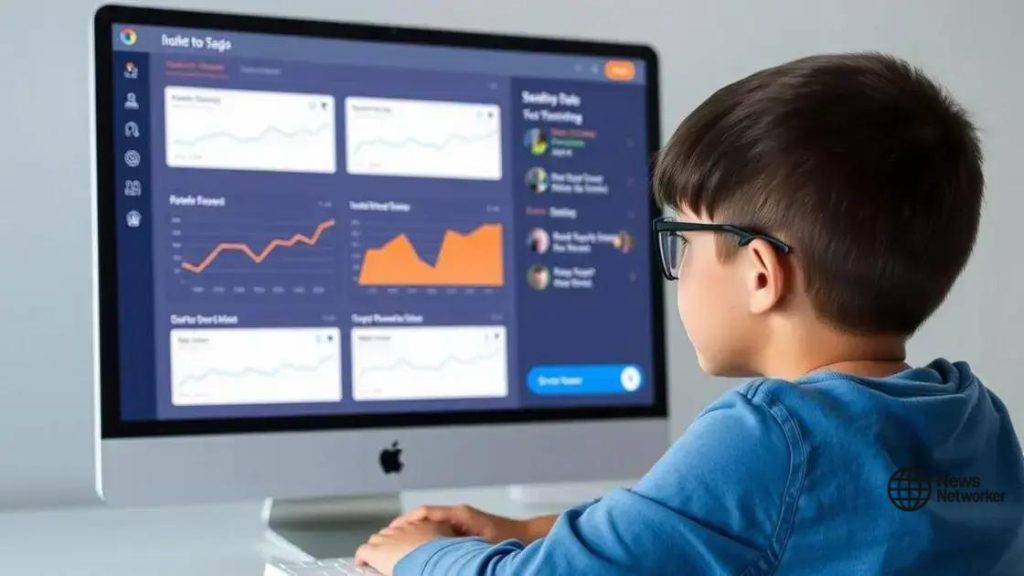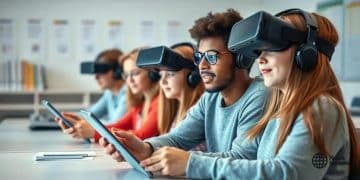Algorithm-driven learning path recommendations that boost your skills

Algorithm-driven learning path recommendations personalize education by adapting content to individual student needs, enhancing engagement and learning outcomes through real-time feedback and tailored resources.
Algorithm-driven learning path recommendations are transforming education by tailoring content to individual needs. Have you ever wondered how technology can enhance your learning journey?
Understanding algorithm-driven learning paths
Understanding algorithm-driven learning paths is essential in today’s educational landscape. These learning paths adjust based on a learner’s specific needs and preferences, making education more effective and personalized.
What are algorithm-driven learning paths?
Algorithm-driven learning paths utilize data and algorithms to create a tailored educational experience. By analyzing how students learn, these algorithms can recommend resources, courses, and activities that cater to individual learning styles and interests.
Benefits of algorithm-driven learning paths
- Personalization: Each learner receives a unique path that suits their pace and understanding.
- Efficiency: Students can focus on areas that need improvement, maximizing their study time.
- Engagement: Customized content keeps learners more engaged and motivated.
Moreover, by leveraging a wealth of data—from previous assessments to user interactions—educational platforms can refine their recommendations over time. This continuous improvement ensures that learners receive the most relevant materials.
The impact of algorithm-driven learning paths extends beyond personalization; it also enhances the educational experience overall. For instance, when students work at their own pace, they develop a deeper understanding of the material. In contrast, traditional methods often lead to frustration and disengagement when content is too advanced or too simple.
Examples in practice
Many modern educational platforms, such as Khan Academy and Coursera, employ algorithmic recommendations to guide learners through their content. These platforms not only adapt based on performance but also incorporate feedback mechanisms to refine future recommendations. As a result, students enjoy a custom-tailored learning journey that evolves according to their progress.
Benefits of personalized learning recommendations
The benefits of personalized learning recommendations are vast and transformative. By harnessing algorithms that tailor educational experiences, learners can engage in a way that best suits their unique needs.
Enhanced Learning Efficiency
One significant advantage of personalized recommendations is improved learning efficiency. When students receive content that matches their skill level, they can grasp concepts faster, leading to better retention. This targeted approach helps prevent frustration from material that is too challenging or boredom from content that is too simple.
Increased Engagement
Engagement is another crucial benefit. Personalized learning paths keep students interested and motivated. When learners engage with material that resonates with them, they tend to spend more time studying and exploring topics in depth. This connection to the content significantly enhances their overall educational experience.
- Motivation: Tailored content encourages students to take ownership of their learning journey.
- Relevance: Students are more likely to connect with material that is aligned with their interests.
- Confidence: Achieving personalized milestones boosts self-esteem and fosters a growth mindset.
Moreover, personalized learning recommendations can accommodate different learning styles. Some students might prefer interactive lessons, while others might excel with visual aids or written content. By adapting to these preferences, educational platforms can create an inclusive environment that benefits everyone.
Another remarkable aspect of personalized learning is the feedback loop it creates. As students interact with the content and make progress, the algorithms can continuously update and refine their learning paths. This dynamic adjustment ensures that the recommendations remain relevant and effective, making learning a progressive journey.
Long-term Benefits
Over time, students who engage with personalized recommendations often see significant improvement in their academic performance. Tailored learning paths not only help in mastering subjects but also foster lifelong learning habits. When students learn how to learn, they develop skills that will serve them well beyond their academic careers.
How algorithms shape educational experiences

Algorithms play a crucial role in shaping educational experiences today. By analyzing data, they help tailor learning paths to meet individual needs and preferences. Understanding how these algorithms function can provide valuable insights into their impact on education.
Data-Driven Personalization
One of the primary ways algorithms shape learning is through data-driven personalization. These systems collect information about a student’s performance, learning style, and pace. By effectively analyzing this data, algorithms can recommend resources that best suit each learner.
Real-Time Feedback
Moreover, algorithms enable real-time feedback. When students engage with content, algorithms track their progress and adjust recommendations accordingly. This quick insight helps learners identify strengths and areas for improvement without waiting for a formal assessment.
- Adaptive quizzes: Algorithms generate questions that adapt based on the learner’s understanding.
- Learning resources: Students are shown articles, videos, or exercises that align with their current knowledge level.
- Progress tracking: Learners can see their advancement, which motivates them to continue.
Furthermore, algorithms analyze patterns over time, which helps educators make informed decisions. These insights can guide instructional strategies and even curriculum development. By recognizing common challenges faced by learners, educators can tailor lessons that address these issues effectively.
These algorithm-driven methods foster an engaging and effective learning environment. Students often find they are more motivated and invested in their education when the content aligns with their interests and abilities. This personalized approach not only enhances learning outcomes but also makes education more enjoyable.
Future Implications
Looking forward, the role of algorithms in education will likely expand. As technology continues to evolve, learning platforms will become increasingly sophisticated. They will harness larger sets of data, potentially offering even more precise and insightful recommendations that can adapt to a wide array of learning preferences.
Real-world applications of learning path algorithms
Real-world applications of learning path algorithms showcase their effectiveness in creating engaging educational experiences. These algorithms are used in various settings, such as schools, online learning platforms, and corporate training programs. They help personalize education by ensuring that learners progress at their own pace.
Online Learning Platforms
Many online learning platforms, such as Coursera and Udemy, utilize learning path algorithms to recommend courses based on a user’s prior knowledge and goals. These platforms analyze user data to tailor course suggestions, ensuring that learners receive the most relevant content. This personalized approach helps improve user satisfaction and retention rates.
K-12 Education
In K-12 education, schools are increasingly adopting algorithm-driven systems to enhance student learning. These systems assess students’ strengths and weaknesses, allowing teachers to create personalized learning paths for each student. By providing tailored resources and assignments, educators can better support diverse learning styles within their classrooms.
- Adaptive Learning Systems: These systems adjust the difficulty of assignments based on student performance.
- Progress Monitoring: Teachers can track student progress in real-time, identifying those who need additional support.
- Customized Assessments: Students receive assessments tailored to their learning paths, promoting mastery of content.
Corporate training programs also benefit from learning path algorithms. Companies use these algorithms to develop personalized training plans for employees. By taking into account each employee’s job role, skills, and previous training, organizations can create tailored learning experiences that boost workforce productivity.
Furthermore, learning path algorithms promote lifelong learning by providing users with ongoing recommendations even after they complete formal education. Whether for professional skills or personal interests, the ability to continue learning through personalized pathways is invaluable.
Future Prospects
As technology continues to evolve, the real-world applications of learning path algorithms will likely expand further. Innovations in artificial intelligence and machine learning may lead to even more sophisticated algorithms, providing increasingly refined and personalized learning experiences.
Future trends in algorithm-driven education
Future trends in algorithm-driven education promise to reshape how we learn and teach. As technology advances, algorithms will become even more integral to providing personalized educational experiences.
Increased Use of Artificial Intelligence
One significant trend is the growth of artificial intelligence in educational platforms. AI will enhance the ability of algorithms to analyze vast amounts of data. This will allow for more accurate predictions about student performance and preferences, leading to better customization of learning paths.
Integration of Virtual and Augmented Reality
Another exciting development is the integration of virtual and augmented reality (VR and AR) into learning environments. These technologies can offer immersive experiences that engage learners in new ways. Algorithms will play a crucial role in adjusting these experiences based on user interaction, ensuring that students receive the most beneficial and relevant content.
- Personalized Immersive Learning: Learning paths can adapt in real-time, providing students with tailored virtual experiences.
- Enhanced Engagement: AR and VR can captivate learners, making complex subjects more understandable.
- Experiential Learning: Students can practice skills in a safe environment, boosting confidence and mastery.
Additionally, the concept of microlearning is gaining traction. Microlearning focuses on delivering education in small, manageable units. Algorithms can help identify the best times to deliver this information, ensuring that learning happens at the right moment and in the right context.
Furthermore, we can expect an increase in collaborative learning environments supported by algorithms. These platforms will connect learners with similar interests and needs, fostering peer learning. Algorithms will help facilitate group dynamics by pairing students effectively, leading to meaningful discussions and collaborative projects.
Data Privacy and Ethics
As education becomes more algorithm-driven, issues related to data privacy and ethics will become increasingly important. Educational institutions will need to uphold data protection standards while leveraging the power of algorithms to enhance learning experiences. Balancing innovation with ethical considerations will be vital.
FAQ – Frequently Asked Questions about Algorithm-Driven Education
How do learning path algorithms enhance student engagement?
Learning path algorithms personalize content for each student, making lessons more relevant and engaging based on their individual needs and preferences.
What role does artificial intelligence play in education?
Artificial intelligence enhances the ability of algorithms to analyze student data, leading to more accurate and personalized educational recommendations.
How can virtual reality be integrated into learning?
Virtual reality can provide immersive learning experiences, allowing students to explore subjects in a hands-on way while algorithms adjust content based on engagement.
What are the challenges related to data privacy in algorithm-driven education?
As educational data becomes more personalized, ensuring the privacy and protection of student information is critical to maintaining trust and compliance with regulations.





